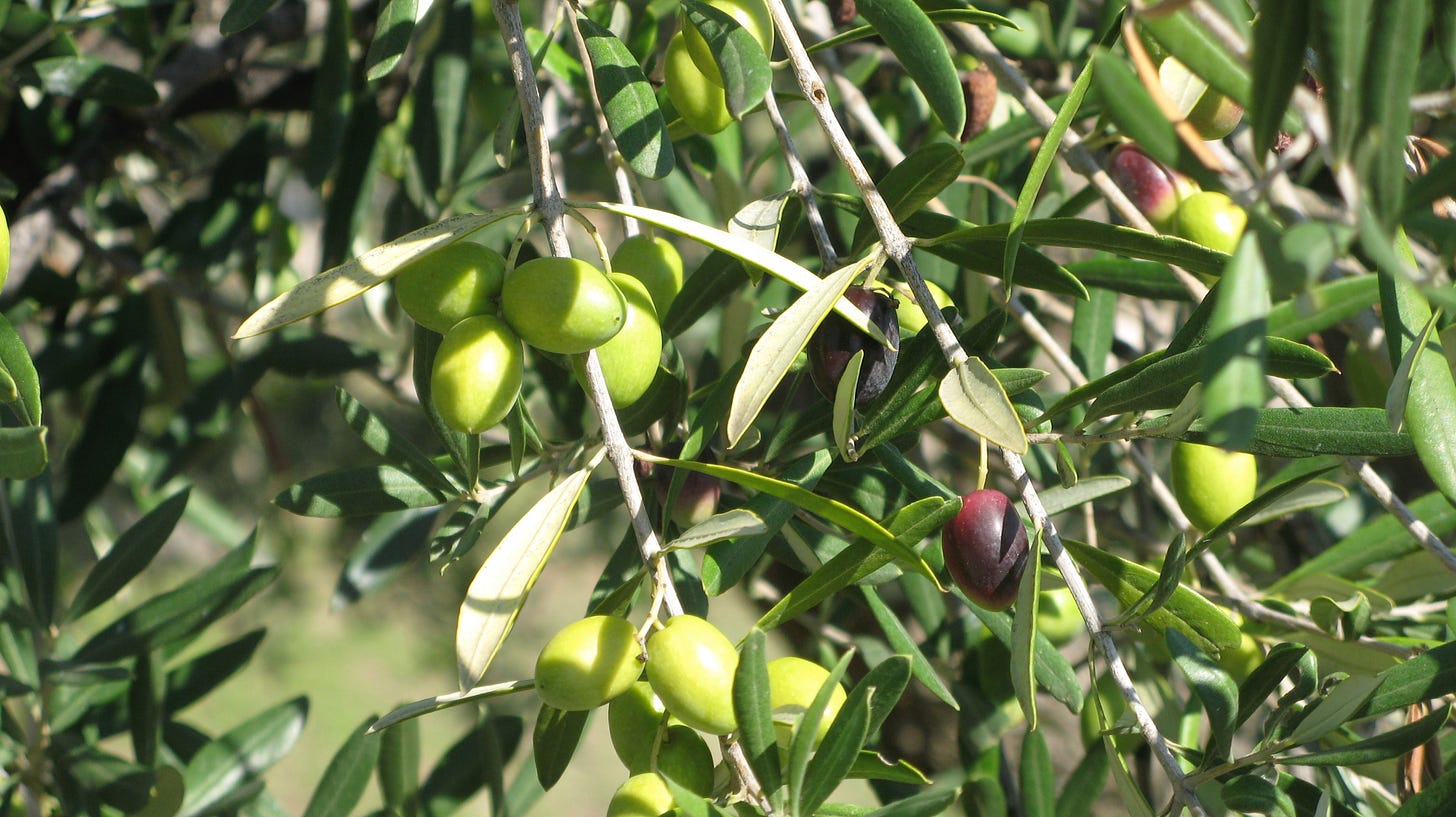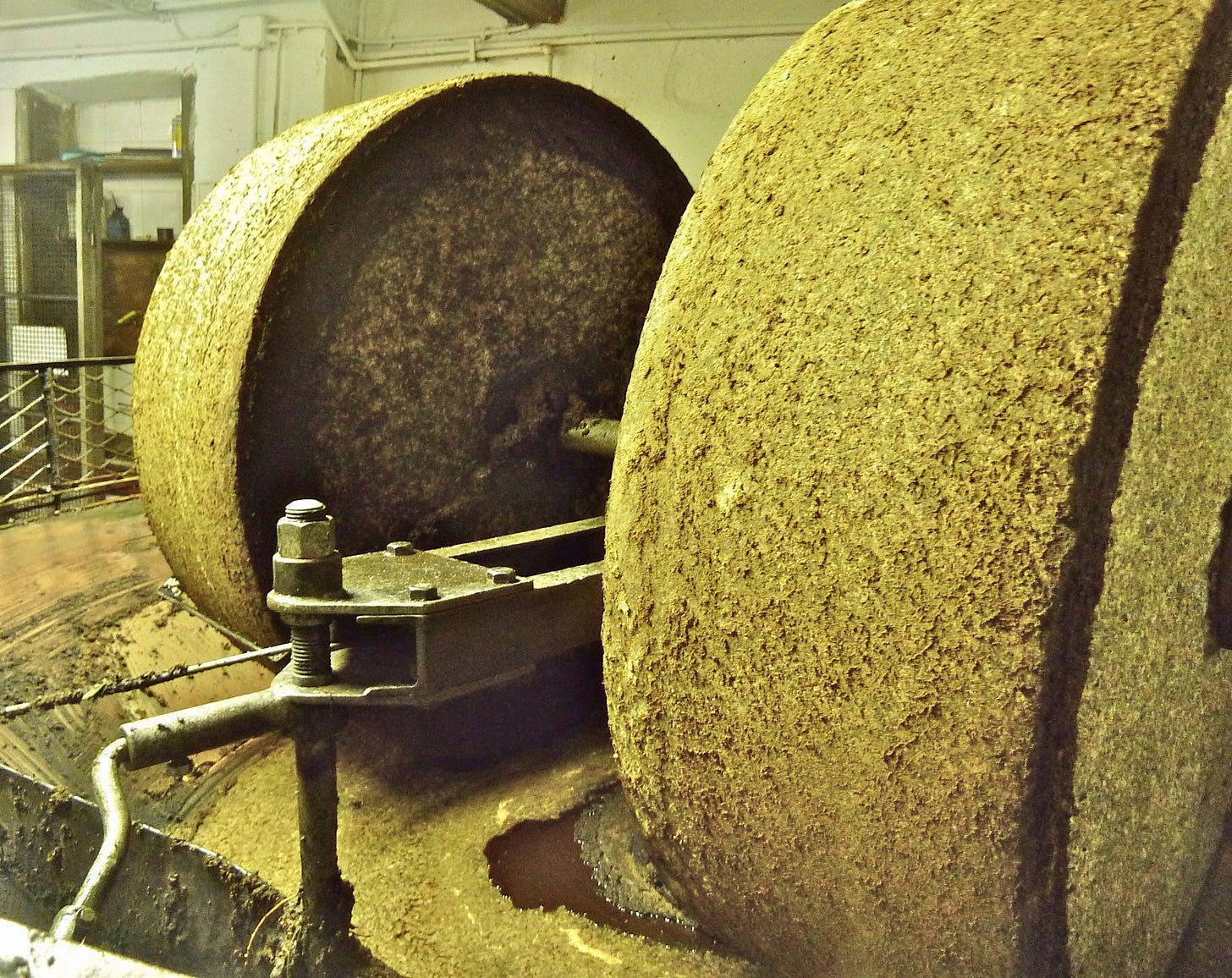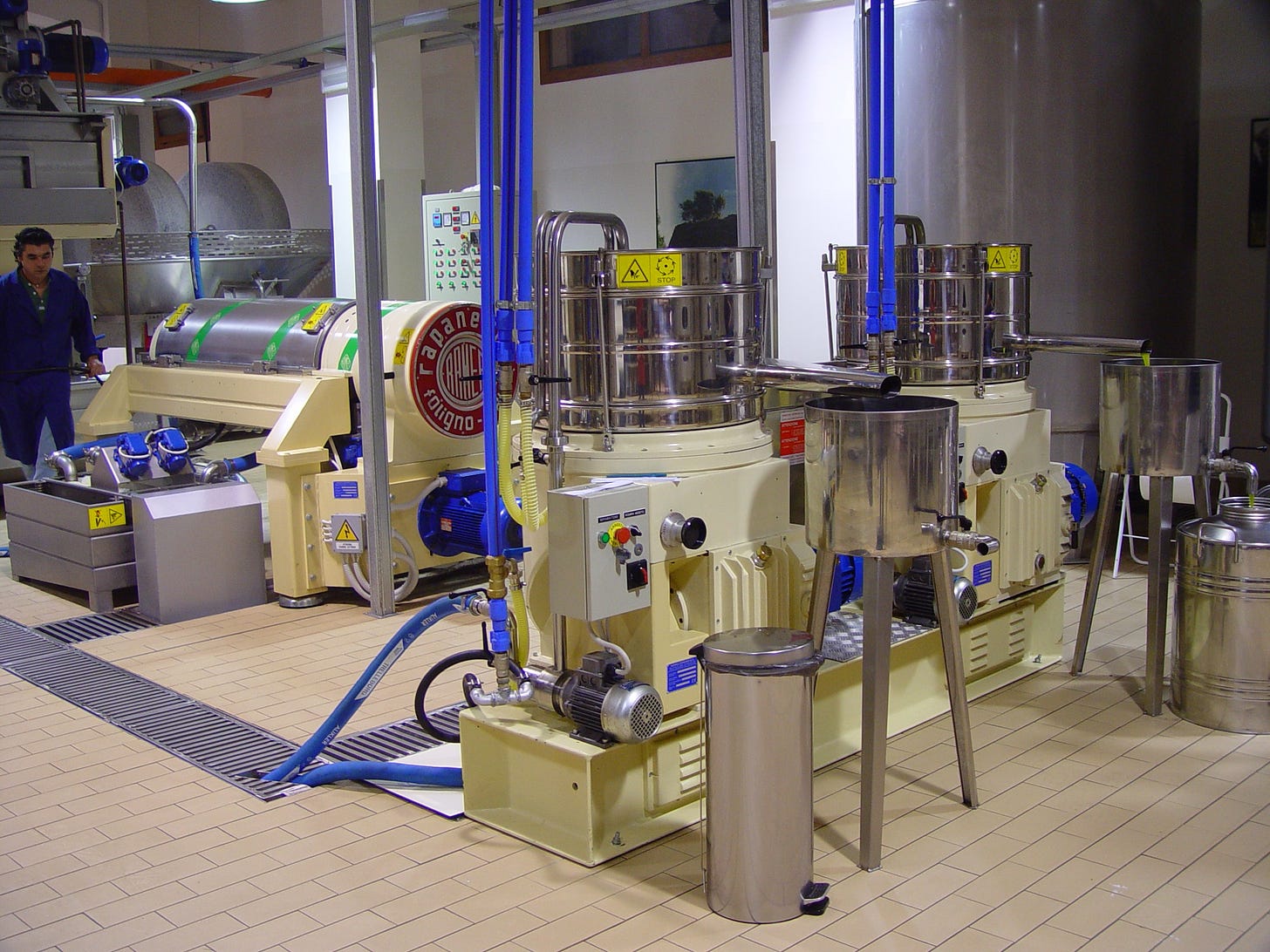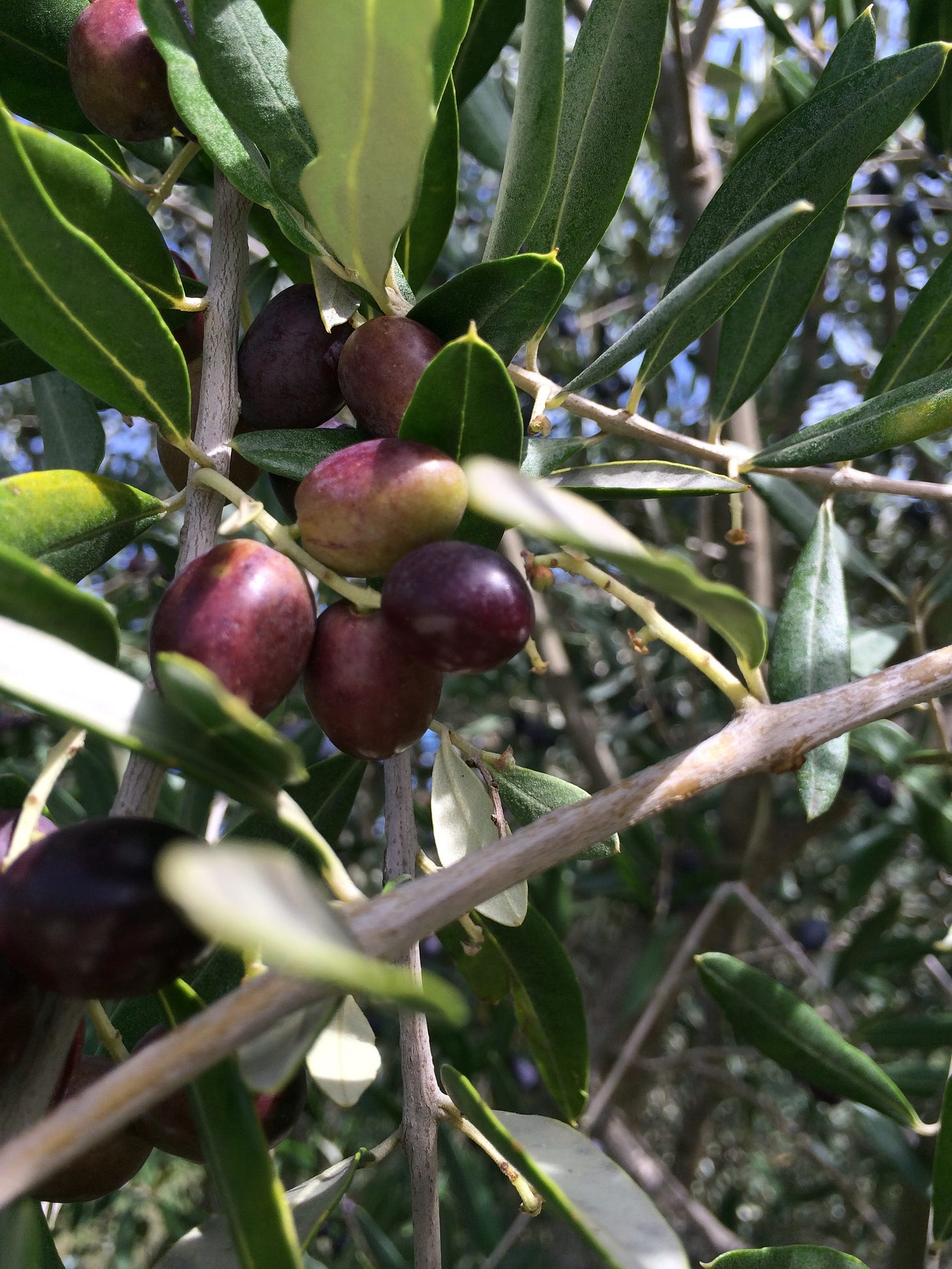In the hills south of Assisi in Umbria is a village called Capodacqua di Foligno where, in late October during the olive harvest, I would often drop in at the Fancelli mill, the frantoio it’s called in Italian, to watch and smell and taste as the big stone presses whirled, crushing the olives in their basins, and the fragrance rose on the air, and, finally, the thick, luscious oil was poured sedately but steadily onto a crust of toasted bread, sprinkled with salt and rubbed with garlic, for the first sampling of the new oil.
I speak of the mill in the past tense because I haven’t been there in years and the only answer I get on the phone is that the number is not working so I have to assume Feliciano Fancelli is no longer making oil. In any case, it was something of a relic, even 20 years ago, a modest, old-fashioned place that I liked in part because the oil they produced was the rich, green stuff typical of this region of Umbria where the Moraiolo cultivar reigns supreme. When young and fresh, the oil slides down your throat with the peppery pizzica, the catch at the back of the palate that’s typical of oil pressed from immature, half-green olives, high in the healthful polyphenols that give it complex flavors and aromas. And Moraiolo olives, the favored variety in Umbria, are notably high in polyphenols.
This is the oil connoisseurs seek out much as they do the fine Sagrantino wines of the same region. Like the wines, the oil has a unique character. It speaks of the terraced hills around Capodacqua with a voice that is subtly different from that of equally flavorful oils from nearby Orvieto and Cortona. And all these pungent, green-tasting, Central Italian oils are very different themselves from the rounder, more succulent oils from Puglia or Sicily. Which again are distinctive from the oils of Catalonia with their hints of almond, the richer, full-bodied oils from Greece and farther east in Lebanon, and the bland, sweet oils from North Africa.
Even 20 years ago, the Fancelli frantoio was one of the last traditional mills left anywhere in Italy. Apart from the fact that electricity was the driving force, rather than mules or human labor, the system was essentially unchanged from Roman times or even earlier. The olives were crushed to an oily paste, then spread on mats that were stacked, one atop the other in what was called a castello or castle.
Slowly pressed over a period of hours, the olives yielded up their oil, drop by drop, along with an abundant rush of vegetable water. Then oil and water were separated, the water discarded, the oil left to filter naturally, precipitating any solid bits to the bottom of a container, whether a stainless steel fusto or a more traditional terracotta orcio, until the oil was as clear and clean as it could get.
Nowadays, throughout the Mediterranean olive world, serious producers have switched over to modern, stainless-steel, continuous-cycle machinery that extracts the oil quickly and efficiently but without the inherent drama and romance of the Capodacqua mill. It’s not picturesque, since it all happens inside the machinery, but it’s fast and it’s clean. Critics say you’ll never get clean oil with the old-fashioned system—it’s too slow and it exposes the crushed olives to damaging oxidation; others claim the modern method produces clean oil, yes, but without the character, the stamp of individuality, that the older mills produced.
Whether old-fashioned or new-fangled, however, this is all 100% extra-virgin olive oil. That’s because the process is essentially a simple one, squeezing good, sound, healthy olives to extract their oil, then separating the vegetable water by precipitation or centrifuging. But no chemical solvents are used to extract or to clean the oil, and no heat is applied. This is what food writers like to call a “first cold pressing,” although the term is deceptive since there is no second pressing, no hot pressing. In order to qualify as extra-virgin, the oil has to be produced without any application of heat at all, so to say “first cold pressing” is something of an oxymoron.
There are other ways of getting oil by using chemical solvents, a process applied to olives that, for one reason or another, are not sufficiently high in quality to produce extra-virgin oil. The oil from poor-quality olives is stripped of its bad flavors and aromas, leaving a colorless, tasteless, aroma-less oil to which a little extra-virgin is added to give it some reason for calling it olive oil, plain and simple, but never extra-virgin. The only virtue of plain “olive oil” is that, like extra-virgin, it’s primarily a monounsaturated fat, but as it’s also a highly processed fat, I don’t recommend using it.
It’s important to note that all olive oil, extra-virgin and regular alike, has impressive health benefits because of its high quotient of monounsaturated fat. But extra-virgin olive oil has the further virtue that, because it is minimally processed, it retains many of the valuable phytochemicals that are present in olives, especially antioxidant carotenoids and tocopherols (Vitamin E)—and these are lost during the processing that produces plain olive oil.
A Fundamental Question: Grapes or Olives?
I took up olive culture some decades ago when I planted 150 Leccino olive trees on the land my family owns in Tuscany, right on the border with Umbria. I did that because I couldn’t afford to live on the land permanently (I had to work and there was no work for a journalist in the remote hills of eastern Tuscany) and yet the land had to be cared for. Fallow land simply went to the bottom of the to-do list for my caretakers, so I had to convince them of the value of what I had.
The question was fundamental: grapes or olives? Grapes require a lot of care throughout the year, pruning, fertilizing, harvesting, pressing, and then carefully curating the wine that, with luck, would result. Olives, on the other hand, are easy—you plant, you prune every other year (if that), you fertilize if and when you come across a good supply of well-rotted sheep manure, you harvest, and you immediately make oil. And that’s it. There’s no fermenting, no blending, no testing, no pumping over, no fining, no fiddling, no cellaring, Piece of cake, right?
Well, not quite. But it’s true, growing olives, harvesting them, and making oil is a lot less complicated than grapes and wine. Of course, the oil is only good for a couple of years, if that, while the wine, if well-made and well cared for, just keeps getting better. But with 150 trees, plus the dozen that were already on our land when we bought it, we tend to use the oil almost as fast as we make it.
It’s October as I write this and my family are gathering at what I still think of as “my” olive farm to harvest this year’s crop. I won’t be there this year for complicated reasons but my heart is there nonetheless and I’m eagerly awaiting that first precious taste of this year’s oil which someone will bring back to me in a month or so. The trees I had planted have thrived to an extent I would not have believed possible when I set them in the ground. It’s an accomplishment I’m proud of. And the oil is very, very good.
It's a strange privilege, that of tasting fresh, new oil, one I can’t share with many other people, but once you’ve experienced it, you never go back. You begin an education in olive oil flavors in a way that stays with you from then on. I compare it, only a little frivolously, to fresh orange juice. If you’ve grown up on frozen orange juice concentrate mixed with water, your first taste of the freshly squeezed juice of a blood orange will blow your mind—or open your palate wide to possibilities you never dreamed of. Just so with fresh, new oil.
We usually start off serving it the way they do in the frantoio—thick crusts of unsalted Tuscan bread, toasted over the embers of a wood fire, rubbed while still warm with a cut clove of garlic, then generously (lavishly, I should say) sloshed with fresh oil and a scattering of sea salt. In old-fashioned mills like Fancelli’s, there were always two or three old men, too old to be much help but not too old to kibbitz, seated around a hearth in a corner of the room, patiently toasting, anointing, and offering the fett’unta (which means exactly that, the anointed slice), and also serving up their unsolicited opinions on everything from the price of oil (meaning olive oil, of course) to the negative impact of migrants on the Italian economy (though nothing much gets done in Italy without migrant labor).
So the fett’unta is our first course, almost always followed by a thick, beany soup, made even heartier by the addition of locally grown farro, the ancient wheat now enjoying high status, with a healthy dollop of fresh oil over the top. And, you know, truth be told, you can have your Tuscan Chianina steaks, your rare-in-the-middle slabs of bluefin tuna, even your fresh tomatoes and bitter-green salads, you can have them all because to my mind, to my palate, nothing in the world goes so well with olio nuovo as a plate of Tuscan beans. I offered a recipe for those here. Go back and try them, especially if and when someone arrives on your kitchen porch bearing a bottle of fresh new oil.
There are other recipes for using good olive oil below but first I do want to reiterate something I never tire of saying:
Yes, you can cook with extra-virgin olive oil. And you should.
Contrary to popular (e.g., social media) belief, olive oil does not have a low flash point or smoke point or whatever point you choose. The myth still abounds in North America, particularly among professional chefs, that extra-virgin olive oil is not for cooking, only for dressing salads and garnishing plates. Nothing could be farther from the truth—and the proof is in the fact that all over the Mediterranean, professional chefs would not dream of using anything else. It’s true that smart chefs look for a less expensive, but still well and carefully produced extra-virgin for ordinary cooking and frying, and reserve the fine, expensive, virtually hand-made extra-virgins for those occasions where the full, rich, complex flavors of the oil can be best appreciated. Because we produce our own oil, my family comfortably follows Mediterranean practice, using last year’s oil (now the 2022-23 harvest) for cooking while the fresh, new olio nuovo of this season will be served raw on a salad or to garnish a steak or a beautiful fillet of fresh fish or on lightly steamed seasonal vegetables. Or on that zuppa di fagioli.
Not everyone can do this, of course. But even in cooking, where the heat may drive off more complex flavors, even then, better oil does taste better, although the very finest may be wasted. Very often cooking with extra virgin can contribute mightily to the success of a dish. Just try this: fry an egg in extra virgin and another in refined olive oil or seed oil. Taste them both and you’ll see how much the good oil adds to the egg’s great flavor
Cut to the Chase: What Oil Should I Buy?
Sooner or later, someone is sure to ask me what oil they should use. That advice is simply impossible to give, mostly because many fine oils are not widely available. Moreover, shop owners are all too often not reliable caretakers of fine oils, frequently exposing them to damaging light and heat. I can, however, tell you where to go online to be sure the oil you buy is excellent, well-made, displaying a harvest date that gives you the critical information of when it was produced, and moreover that the person selling the oil stands by what he or she has to offer. These are online sites; there may well be others but I haven’t yet experienced them. (One to avoid is Amazon, which has no control over the quality of its offers.)
The places I know and guarantee are: olio2go; gustiamo.com; markethallfoods.com; zingermans.
In addition, there are two importers of fine oil who don’t sell directly to the public but whom you can address for information about where to find their products. They are: Manicaretti, and The Rogers Collection.
The following is for paid subscribers only. To see the whole post, including recipes, please become a paid subscriber.
Keep reading with a 7-day free trial
Subscribe to On the Kitchen Porch to keep reading this post and get 7 days of free access to the full post archives.








